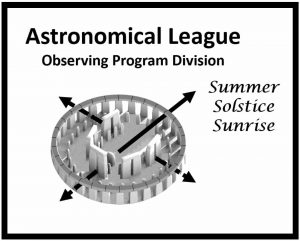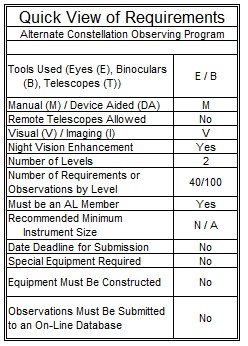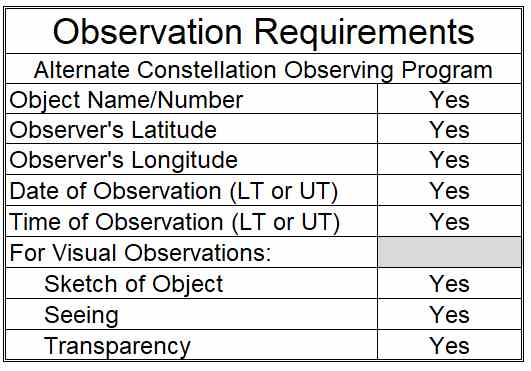 |
IntroductionWelcome to the Astronomical League’s Alternate Constellations Observing Program. The Alternate Constellations Observing Program awards both a certificate and a pin. The purpose of this program is to provide a historical and cultural overview of the sky for today’s amateur astronomers. The program requires no special equipment (other than a standard star atlas and references for the alternate constellations), and no prior knowledge. The objective is to provide a forum for the observer to become more familiar with certain obsolete constellations and the constellations and star patterns developed by cultures outside Europe. Although not required, previous or co-completion of other observation programs such as the Constellation Hunter (North and South), and the Asterism Observing Program would be helpful. Requirements and RulesThis certification is available to members of the Astronomical League, either through their local astronomical society or as members at large. If you are not a member and would like to become one, check with your local astronomical society, search for a local society on the Astronomical League Website, or join as a Member-at-Large . |
 |
To qualify for the Astronomical League’s Alternate Constellations Silver Level certificate you must observe and sketch these required constellations:
To earn the Gold Level pin and certificate, you must complete the Silver Level and also complete both of these components:
|
 |
Binoculars, while not required, will give you a deeper look into the star fields that you sketch. You may find that if your observing site is not as dark as that of the ancient world, you will need at least small binoculars to see all the stars in these constellations. You may use the attached Observation Log Sheet or your own, but it must include all necessary data. For each constellation, you need to provide this information:
- Date and time (either local or UT)
- Latitude and Longitude of observation.
- Alternate Constellation or Star Group name and culture
- Sky conditions: transparency and seeing.
- A sketch of all stars included in the alternate constellation, according to the source used for the figure, with stars from adjacent “official” constellations for clarity. Named stars should be identified on the sketch.
- A copy (pdf, jpeg, or paper) of the source, including attribution OR
- Hyperlink to source with enough detail to certify the star figure as sketched.
- See the specific requirements below for each type of observation.
The sketch should include other interesting objects that are visible within the boundaries of the constellation or group, including but not limited to galaxies, open clusters, globular clusters, and nebulae.
Special Note:
- Please note, that due to issues with differing research interpretations of some of the ancient constellations, you can substitute another constellation from the same culture if you are having difficulty identifying specific constellations of other cultures.
- For example: Te Te – The 2 Groups (Akkadian). This may be replaced by another constellation from the same culture (Asian) as long as all of the requirements of the program are met using the new constellation.
Submitting for Certification
| To receive your Alternate Constellations Certificate and pin, simply send a copy (email copy in pdf format preferred) of your sketches along with your name, mailing address, email address, phone number, and society affiliation, either to your society’s Awards Coordinator for review and approval, or to the Alternate Constellations Observing Program Coordinator. Do not send original materials. They will not be returned to you. |  |
For information on which constellations to study and sketch, read the attached Obsolete Constellations Checklist and Constellations of Other Cultures Checklists. These checklists also detail the specific requirements for each type of object.
There is a Citizen Science Award opportunity related to this program also, at Zooniverse
Upon verification of your submission and of your active membership in the Astronomical League, your recognition (certificate, pin, etc.) will be sent to you or to the awards coordinator for your society, as you specified. Your name will also appear in an upcoming issue of the Reflector magazine and in the Astronomical League’s online database. Congratulations. Good luck with your next observing challenge.
Alternate Constellation Observing Program Coordinator:
Notes:
Resources:
- Wikipedia has several items on both obsolete constellations and those of other cultures
- Living in the Sky; The Cosmos of the American Indian, Ray A. Williamson
- Star Names; Their Lore and Meaning, Richard Hinckley Allen
- Stars of the First People; Native American Star Myths and Constellations, Dorcas S. Miller
- The Modern Scholar: Heavens Above: Stars, Constellations, and the Sky, James B. Kaler



